A Novel Bow-Tie Balun-Fed Dual-Polarized Crossed Dipole Antenna
Abstract
:1. Introduction
2. Working Mechanism
2.1. The Evolution of the Feed Structure
2.2. Bow-Tie Balun
2.3. Antenna Vibrator
3. Parametric Study and Design Guidelines
3.1. The Dimensional Parameters
3.2. The Parametric Study
3.2.1. The Isolation of the Ports of the Bow-Tie Baluns
3.2.2. The Height of the Bow-Tie Balun hBB
3.2.3. The Side Length of the Bow-Tie Balun lBB3
3.2.4. The Gap between Two Bow-Tie Baluns gBB
3.2.5. The Height of the Slot between Two Bow-Tie Baluns and MP hslot
3.3. Design Guideline
4. Simulated and Experimental Results
4.1. The Simulated Radiation Characteristics of the Dipole Antennas
4.2. The Effect of the Fences
4.2.1. The EM Characteristic Comparison of the Models with and without the Fences
4.2.2. The Effect of the Fences at Different Frequencies
4.3. The Experimental Results
5. Conclusions
Author Contributions
Funding
Data Availability Statement
Conflicts of Interest
References
- Wang, B.; Liao, C.; Du, C.H. A Low-Profile Broadband Dual-Polarized Base Station Antenna Array With Well-Suppressed Cross-Polarization. IEEE Trans. Antennas Propag. 2021, 69, 8354–8365. [Google Scholar] [CrossRef]
- Li, Y.; Chu, Q.X. Shared-Radiator Design of Dual-Band Coplanar Base Station Antenna Array Using Cavity-Backed Slots. IEEE Trans. Antennas Propag. 2021, 69, 8985–8990. [Google Scholar] [CrossRef]
- Liu, X.; Gao, S.; Hu, W.; Wen, L.; Luo, Q.; Sanz-Izquierdo, B.; Yang, X.X. A Compact Dual-Polarized Filtering Antenna With Steep Cut-Off for Base-Station Applications. IEEE Trans. Antennas Propag. 2022, 70, 5941–5946. [Google Scholar] [CrossRef]
- He, Y.; Huang, W.; He, Z.; Zhang, L.; Gao, X.; Zeng, Z. A Novel Cross-Band Decoupled Shared-Aperture Base Station Antenna Array Unit for 5G Mobile Communications. IEEE Open J. Antennas Propag. 2022, 3, 583–593. [Google Scholar] [CrossRef]
- Li, J.; Hao, S.J.; Cui, Y.G.; Chen, X. A Miniaturized Wideband Dual-Polarized Planar Antenna Based on Multiresonance. IEEE Antennas Wirel. Propag. Lett. 2022, 21, 242–246. [Google Scholar] [CrossRef]
- Ye, L.H.; Yuanjun, L.; Wu, D.L. Dual-Wideband Dual-Polarized Dipole Antenna With T-Shaped Slots and Stable Radiation Pattern. IEEE Antennas Wirel. Propag. Lett. 2022, 21, 610–614. [Google Scholar] [CrossRef]
- Han, B.; Wu, Q.; Yu, C.; Wang, H.; Gao, X.; Ma, N. Ultracompact Dual-Polarized Cross-Dipole Antenna for a 5G Base Station Array With a Low Wind Load. IEEE Trans. Antennas Propag. 2022, 70, 9315–9325. [Google Scholar] [CrossRef]
- Xiong, H.Q.; Zhang, C.J.; Tong, M.S. Wideband Low-Profile Dual-Polarized Antenna Based on a Gain-Enhanced EBG Reflector. IEEE Trans. Compon. Packag. Manuf. Technol. 2022, 12, 391–394. [Google Scholar] [CrossRef]
- Biswas, S. Wideband and Dual-Polarized Crossed Dipole Antenna Design Using Substrate-Integrated Coax. IEEE Open J. Antennas Propag. 2023, 4, 361–372. [Google Scholar] [CrossRef]
- Qin, Y.; Zhang, L.; Mao, C.X.; Zhu, H. A Compact Wideband Antenna With Suppressed Mutual Coupling for 5G MIMO Applications. IEEE Antennas Wirel. Propag. Lett. 2023, 22, 938–942. [Google Scholar] [CrossRef]
- Jiang, J.; Chu, Q.X. Dual-Band Shared-Aperture Base Station Antenna Array Based on 3-D Chokes. IEEE Antennas Wirel. Propag. Lett. 2023, 22, 824–828. [Google Scholar] [CrossRef]
- Peng, J.D.; Li, X.L.; Ye, L.H.; Li, J.F.; Wu, D.L.; Zhang, X.Y. Low-Profile Wideband Dual-Polarized Dipole Antenna With Parasitic Strips and Posts. IEEE Antennas Wirel. Propag. Lett. 2023, 22, 844–848. [Google Scholar] [CrossRef]
- Ye, L.H.; Chen, Z.; Li, J.F. Ultra-Wideband Dual-Polarized Base-Station Antenna With Stable Radiation Pattern. IEEE Trans. Antennas Propag. 2023, 71, 1919–1924. [Google Scholar] [CrossRef]
- Tan, X.; Mei, X.; Wu, K.L. XPD Enhancement of Dipole Antenna Arrays by Inducing Coherent Current From Feeding Line. IEEE Trans. Antennas Propag. 2023, 71, 3950–3958. [Google Scholar] [CrossRef]
- Fu, S.; Cao, Z.; Quan, X.; Xu, C. A Broadband Dual-Polarized Notched-Band Antenna for 2/3/4/5G Base Station. IEEE Antennas Wirel. Propag. Lett. 2020, 19, 69–73. [Google Scholar] [CrossRef]
- Ou, J.H.; Chen, Z.; Bo, S.F.; Zhang, Y.; Zhang, X.Y. Compact Dual-Polarized Antenna with Low-Pass Response for Marine Communication. IEEE Trans. Veh. Technol. 2021, 70, 2649–2656. [Google Scholar] [CrossRef]
- Liu, X.; Gao, S.; Sanz-Izquierdo, B.; Zhang, H.; Wen, L.; Hu, W.; Yang, X.X. A Mutual-Coupling-Suppressed Dual-Band Dual-Polarized Base Station Antenna Using Multiple Folded-Dipole Antenna. IEEE Trans. Antennas Propag. 2022, 70, 11582–11594. [Google Scholar] [CrossRef]
- Yang, S.J.; Duan, W.; Liu, Y.Y.; Ye, H.; Yang, H.; Zhang, X.Y. Compact Dual-Band Base-Station Antenna Using Filtering Elements. IEEE Trans. Antennas Propag. 2022, 70, 7106–7111. [Google Scholar] [CrossRef]
- Yang, W.; Li, Y.; Xue, Q.; Liao, S.; Che, W. Miniaturized Broadband Dual-Polarized Dipole Antenna Based on Multiple Resonances and its Array for Base-Station Applications. IEEE Trans. Antennas Propag. 2022, 70, 11188–11193. [Google Scholar] [CrossRef]
- Yang, S.J.; Ma, R.; Zhang, X.Y. Self-Decoupled Dual-Band Dual-Polarized Aperture-Shared Antenna Array. IEEE Trans. Antennas Propag. 2022, 70, 4890–4895. [Google Scholar] [CrossRef]
- Li, Y.; Chu, Q.X. Dual-Band Base Station Antenna Array Using the Low-Band Antenna as Parasitic Decoupler. IEEE Antennas Wirel. Propag. Lett. 2022, 21, 1308–1312. [Google Scholar] [CrossRef]
- Chen, Z.; Xu, T.; Li, J.F.; Ye, L.H.; Wu, D.L. Dual-Broadband Dual-Polarized Base Station Antenna Array With Stable Radiation Pattern. IEEE Antennas Wirel. Propag. Lett. 2023, 22, 303–307. [Google Scholar] [CrossRef]
- Liu, Y.; Yue, Z.; Jia, Y.; Xu, Y.; Xue, Q. Dual-Band Dual-Circularly Polarized Antenna Array With Printed Ridge Gap Waveguide. IEEE Trans. Antennas Propag. 2021, 69, 5118–5123. [Google Scholar] [CrossRef]
- Yang, D.; Zhai, H.; Guo, C.; Ma, C. A Novel Differentially Fed Dual-Polarized Filtering Magneto-Electric Dipole Antenna for 5G Base Station Applications. IEEE Trans. Antennas Propag. 2022, 70, 5373–5382. [Google Scholar] [CrossRef]
- Liang, M.S.; Zhou, Y.; Yang, X.S.; Wu, P.F. A Low-Profile Dual-Polarized Substrate Integrated Magneto-Electric Dipole MIMO Antenna. IEEE Antennas Wirel. Propag. Lett. 2023, 22, 1431–1435. [Google Scholar] [CrossRef]
- Wu, S.; Shang, F. Broadband Dual-Polarized Magnetoelectric Dipole Antenna With Compact Structure for 5G Base Station. IEEE Access 2023, 11, 20806–20813. [Google Scholar] [CrossRef]
- Liu, T.; Zhu, W.J.; Hu, X.J.; Ye, L.H.; Wu, D.L. Dual-Wideband Dual-Polarized Magnetoelectric Dipole Antenna for Sub-6 GHz Applications. IEEE Antennas Wirel. Propag. Lett. 2023, 22, 1396–1400. [Google Scholar] [CrossRef]
- Wu, F.; Wang, J.; Zhang, Y.; Hong, W.; Luk, K.M. A Broadband Circularly Polarized Reflectarray With Magneto-Electric Dipole Elements. IEEE Trans. Antennas Propag. 2021, 69, 7005–7010. [Google Scholar] [CrossRef]
- Zhu, H.; Liu, G.; Wang, K.; Mou, J.; Zhou, Y.; Xie, S.; Di, Y. Ultrawideband Compact Magnetoelectric Dipole Antenna/Array With Dual-Polarization. IEEE Trans. Antennas Propag. 2023, 71, 4504–4509. [Google Scholar] [CrossRef]
- Alexandre, L.C.; De Souza Filho, A.L.; Sodré, A.C. Indoor Coexistence Analysis Among 5G New Radio, LTE-A and NB-IoT in the 700 MHz Band. IEEE Access 2020, 8, 135000–135010. [Google Scholar] [CrossRef]
- El Yousfi, A.; Abdalmalak, K.A.; Lamkaddem, A.; Vargas, D.S. Miniaturized Broadband dual-polarized Dielectric Resonator Antenna Using Characteristic Modes. In Proceedings of the 2023 17th European Conference on Antennas and Propagation (EuCAP), Florence, Italy, 26–31 March 2023; pp. 1–4. [Google Scholar] [CrossRef]
- Abdalmalak, K.A.; Romano, S.L.; García, E.; Lampérez, A.G.; Martínez, F.J.H.; Palma, M.S.; Fernández, J.A.L. Radio astronomy ultra wideband receiver covering the 2–14 GHz frequency band for VGOS applications. In Proceedings of the 2016 10th European Conference on Antennas and Propagation (EuCAP), Davos, Switzerland, 10–15 April 2016; pp. 1–5. [Google Scholar] [CrossRef]
- Dawoud, K.A.A. Analysis and design of antennas and radiometers for radio astronomy applications in microwave, Mm-wave, and THz Bands. Ph.D. Thesis, Universidad Carlos III de Madrid, Madrid, Spain, 2022. Available online: http://hdl.handle.net/10016/35126 (accessed on 1 February 2022).
- Zhang, K.; Tan, R.; Jiang, Z.H.; Huang, Y.; Tang, L.; Hong, W. A Compact, Ultrawideband Dual-Polarized Vivaldi Antenna With Radar Cross Section Reduction. IEEE Antennas Wirel. Propag. Lett. 2022, 21, 1323–1327. [Google Scholar] [CrossRef]
- Lu, J.; Shao, Z.; Li, C.; Gu, C.; Mao, J. A Portable 5.8 GHz Dual Circularly Polarized Interferometric Radar Sensor for Short-Range Motion Sensing. IEEE Trans. Antennas Propag. 2022, 70, 5849–5859. [Google Scholar] [CrossRef]
- Kim, D.; Park, C.Y.; Kim, Y.; Kim, H.; Yoon, Y.J. Four-Arm Sinuous Antenna With Low Input Impedance for Wide Gain Bandwidth. IEEE Access 2022, 10, 35265–35272. [Google Scholar] [CrossRef]
- Sun, H.H.; Cheng, W.; Fan, Z. Diameter Estimation of Cylindrical Metal Bar Using Wideband Dual-Polarized Ground-Penetrating Radar. IEEE Trans. Instrum. Meas. 2023, 72, 8000714. [Google Scholar] [CrossRef]
- Kraus, J.D.; Marhefka, R.J. Antennas for All Applications, 2nd ed.; Publishing House of Electronics Industry: Beijing, China, 2008. [Google Scholar]
- Zheng, Y.; Weng, Z.; Qi, Y.; Fan, J.; Li, F.; Yang, Z.; Drewniak, J.L. Calibration Loop Antenna for Multiple Probe Antenna Measurement System. IEEE Trans. Instrum. Meas. 2020, 69, 5745–5754. [Google Scholar] [CrossRef]
- Balanis, C.A. Antenna Theory Analysis and Design, 3rd ed.; Wiley: Hoboken, NJ, USA, 2016. [Google Scholar]
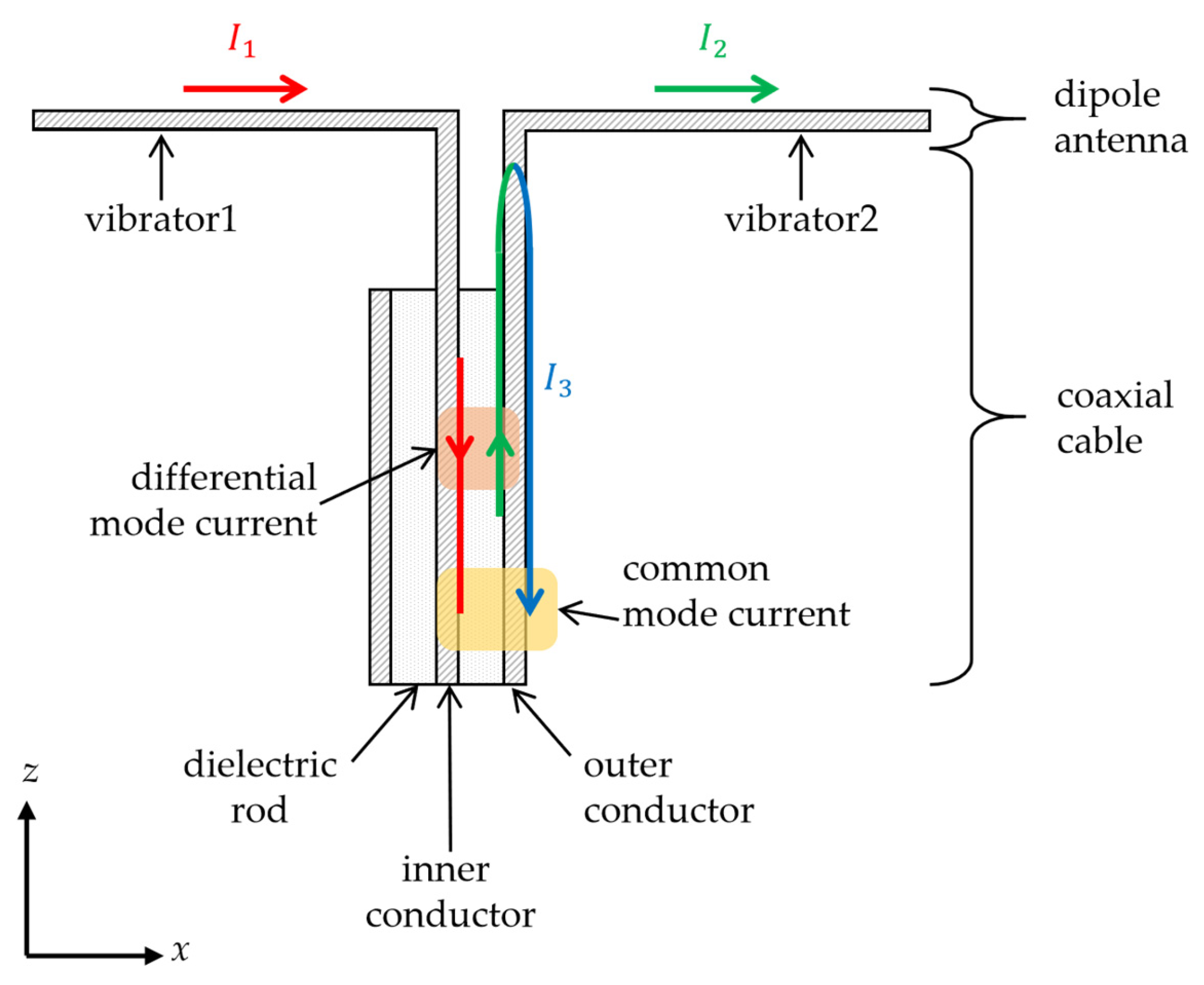
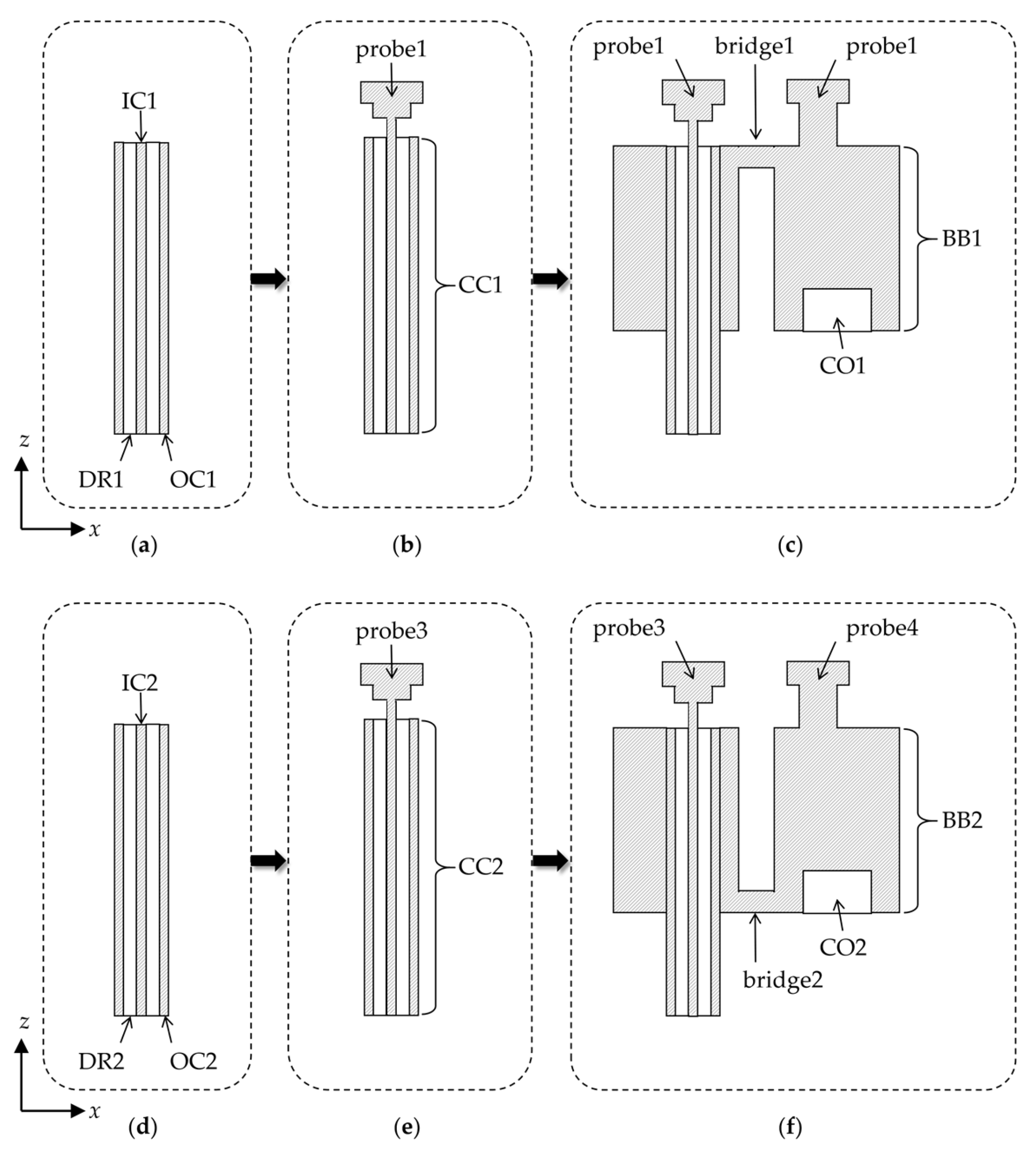
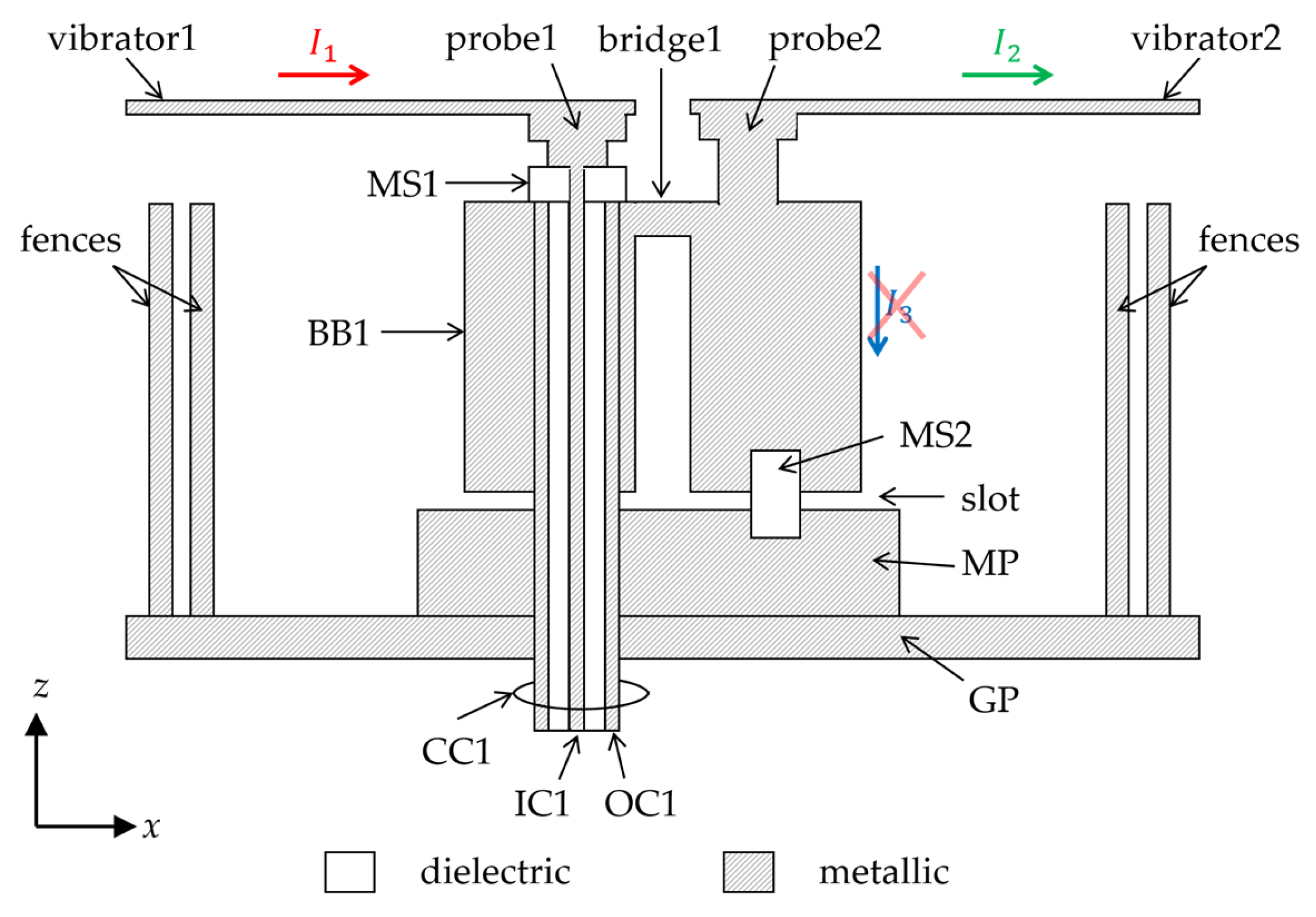
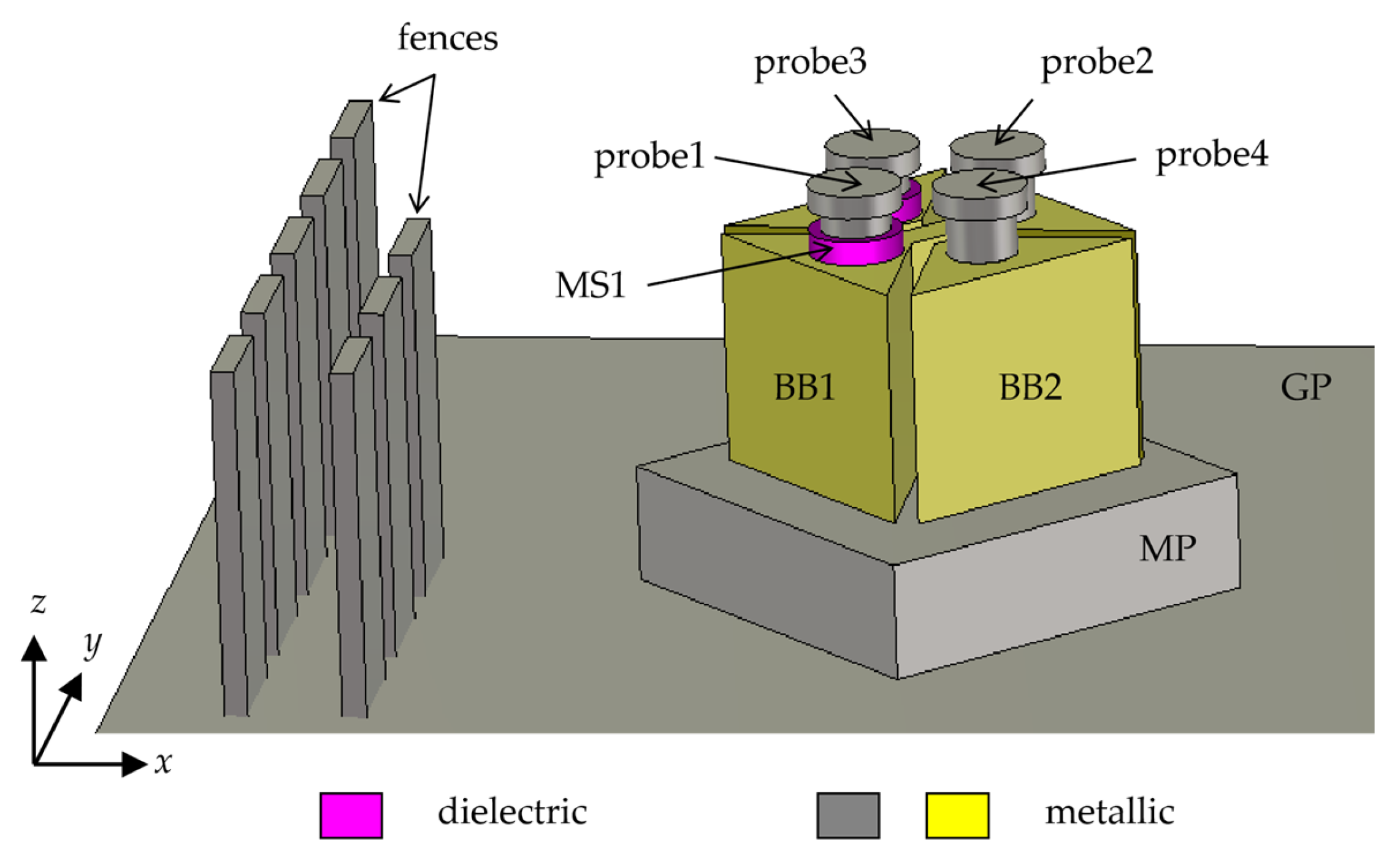
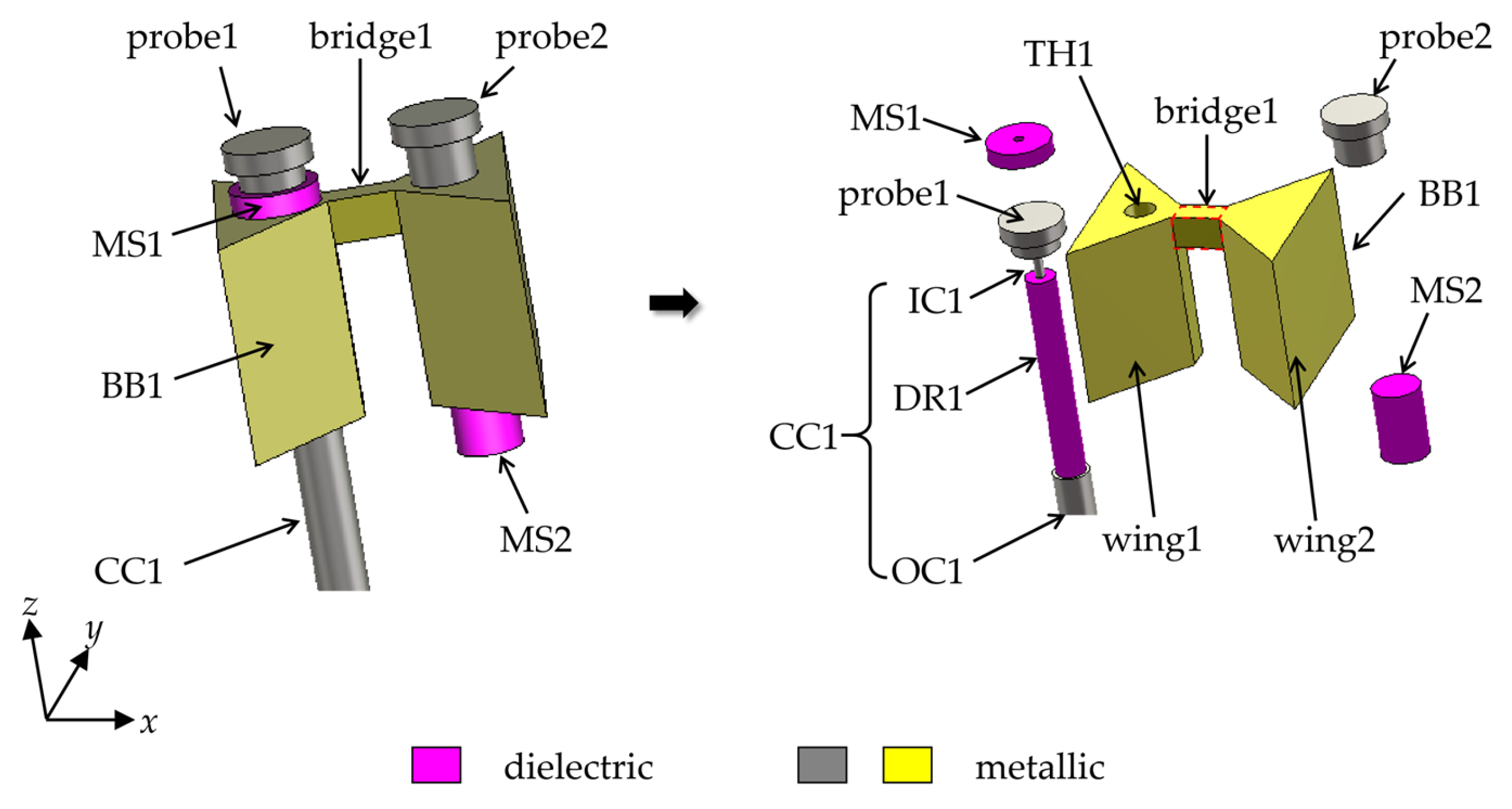
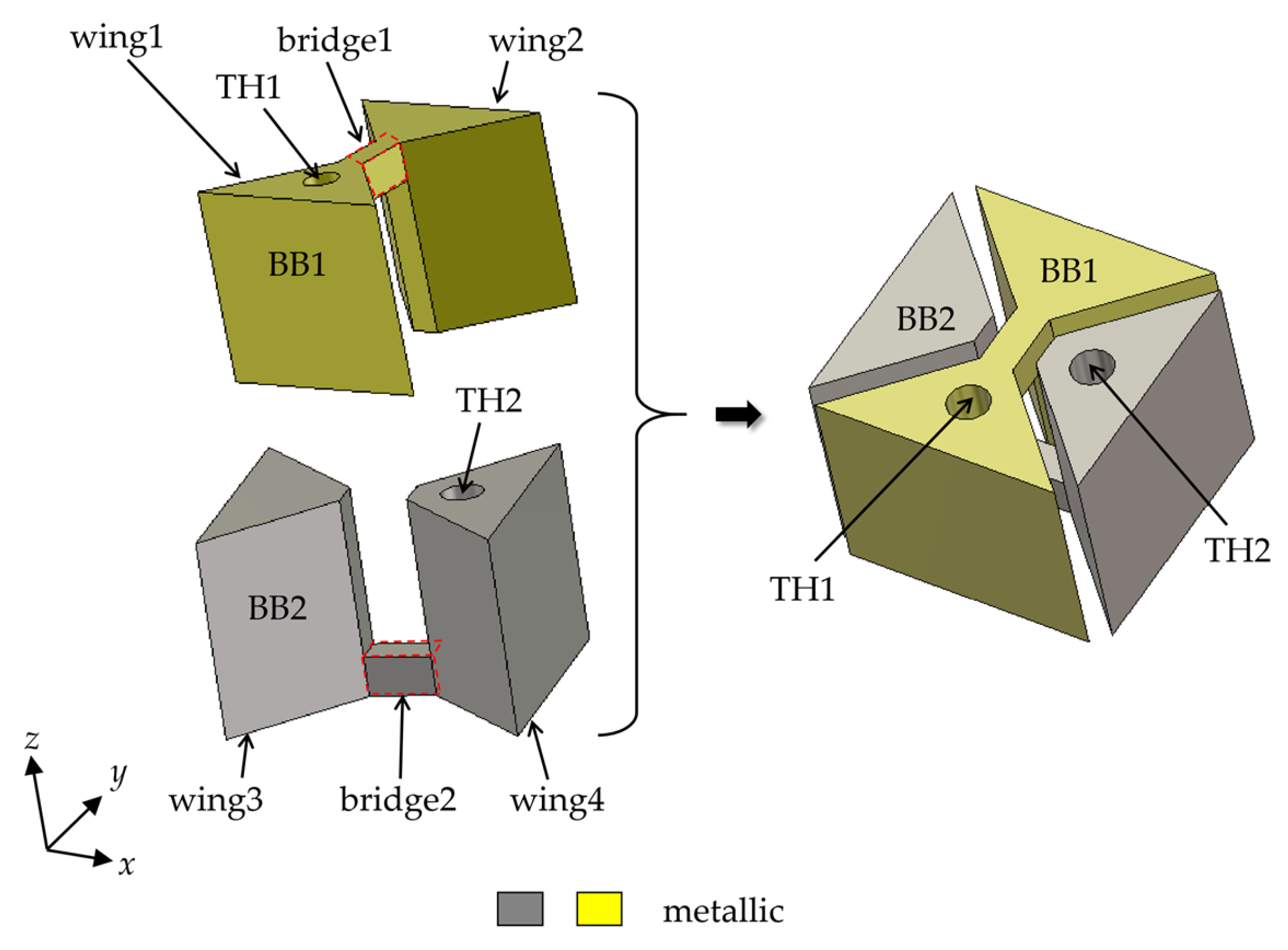
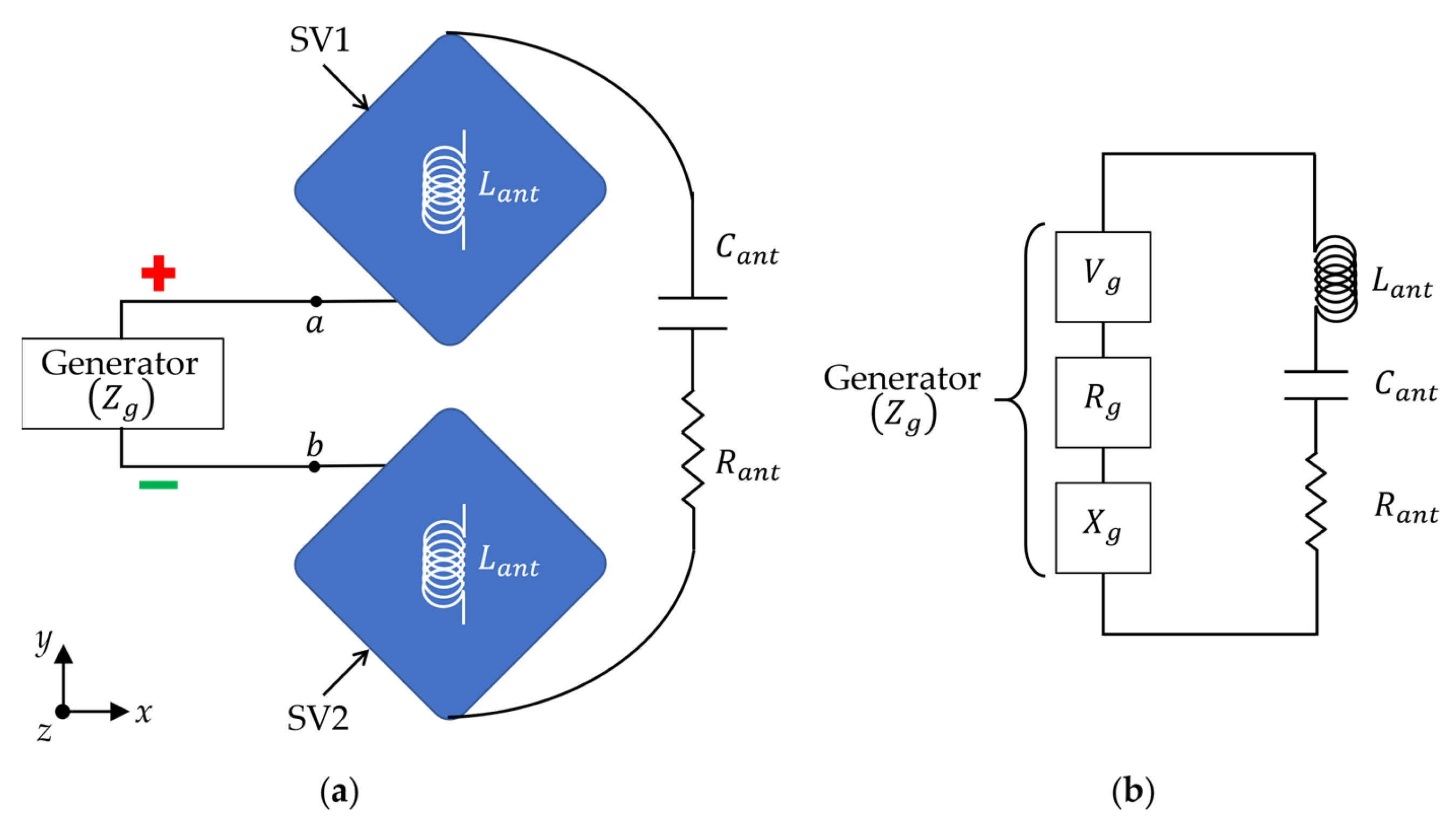

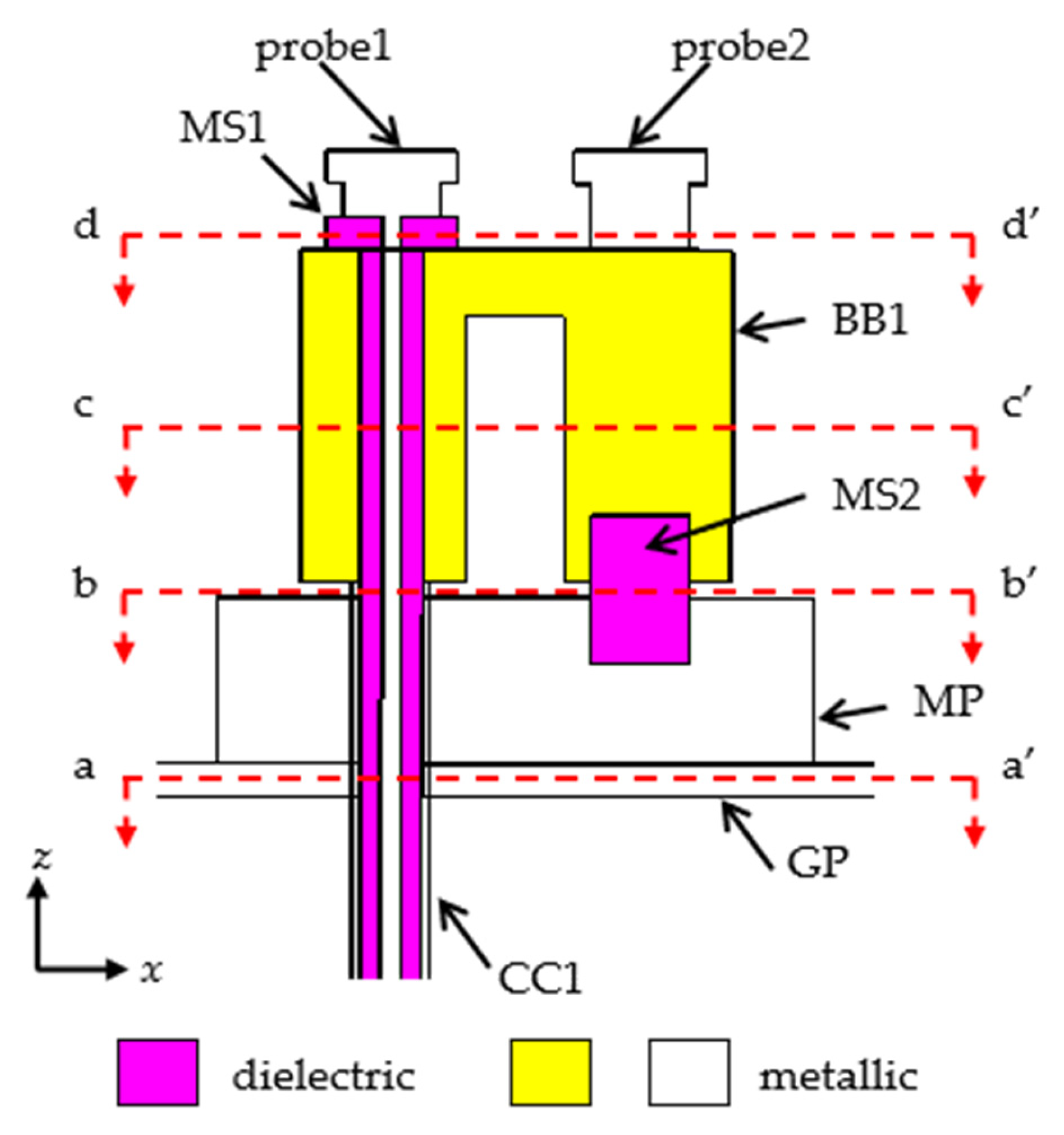

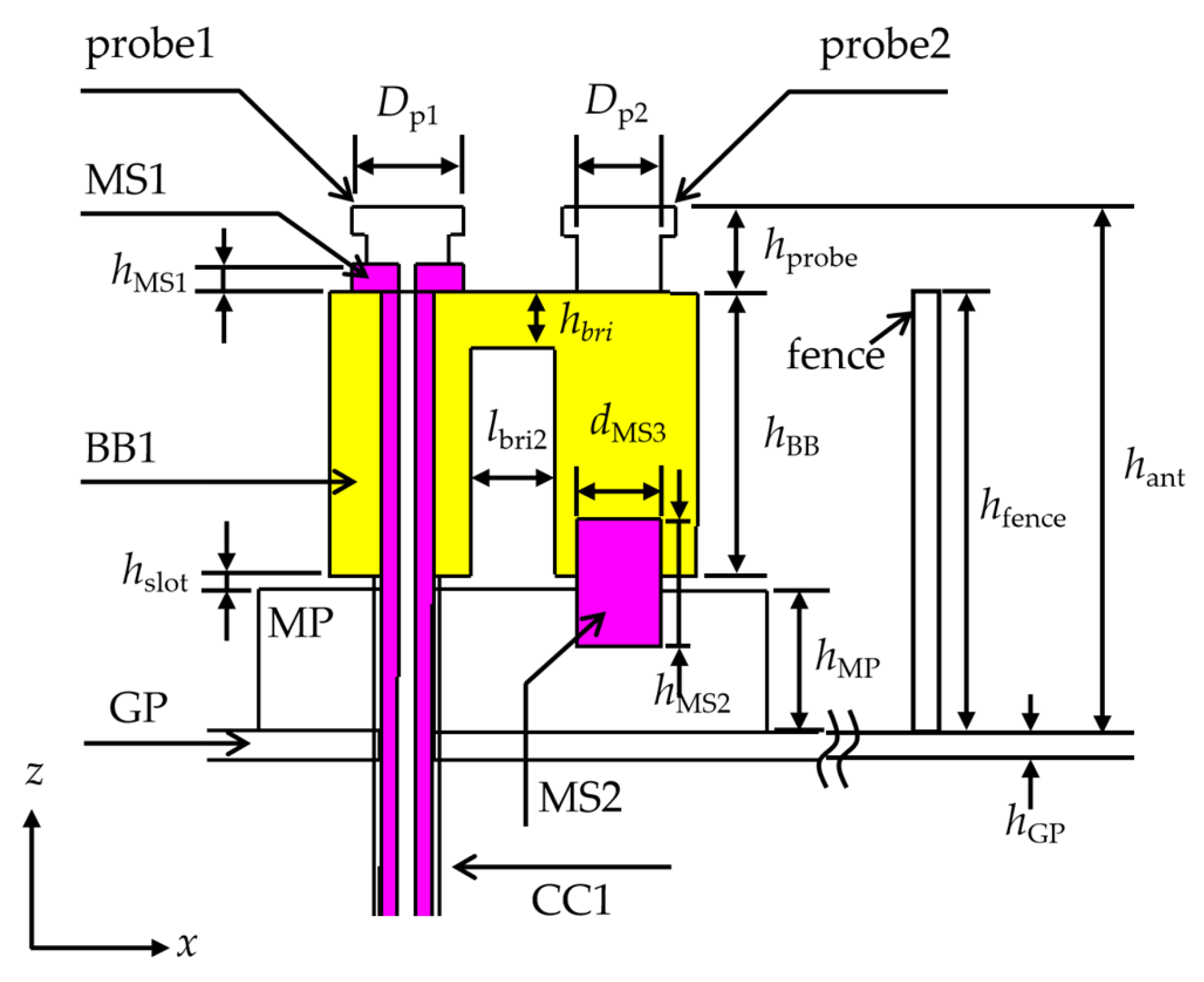
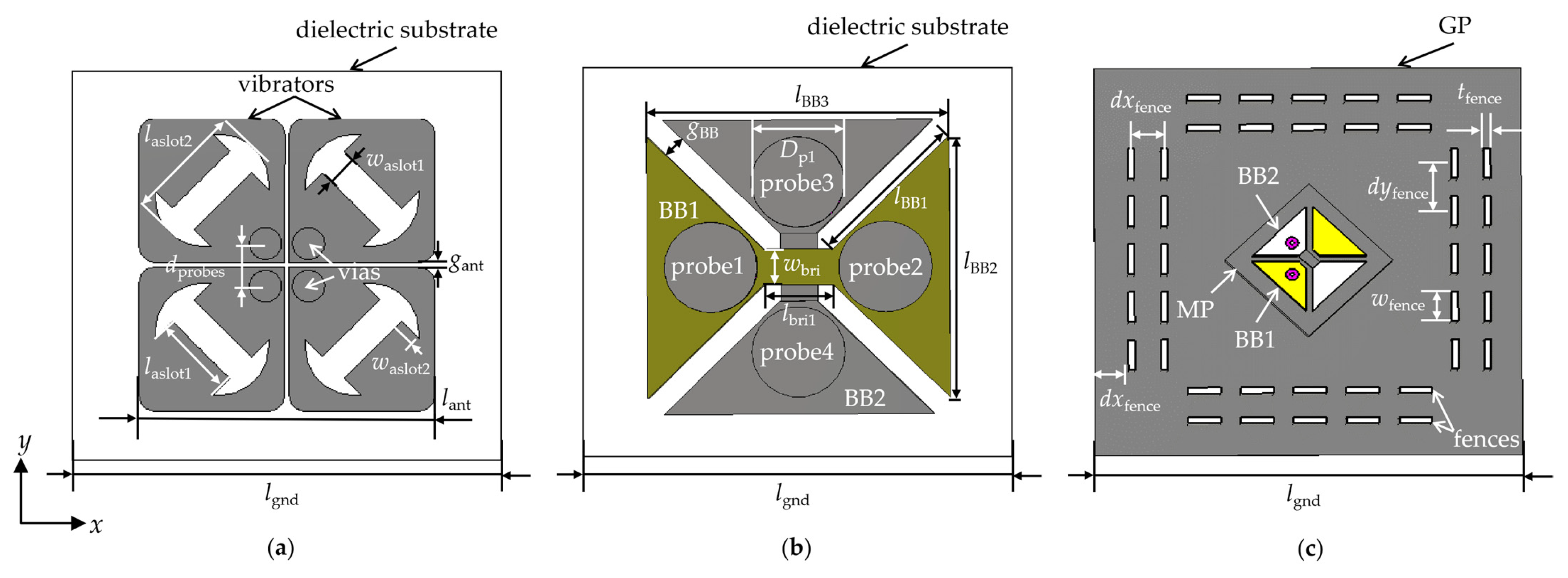

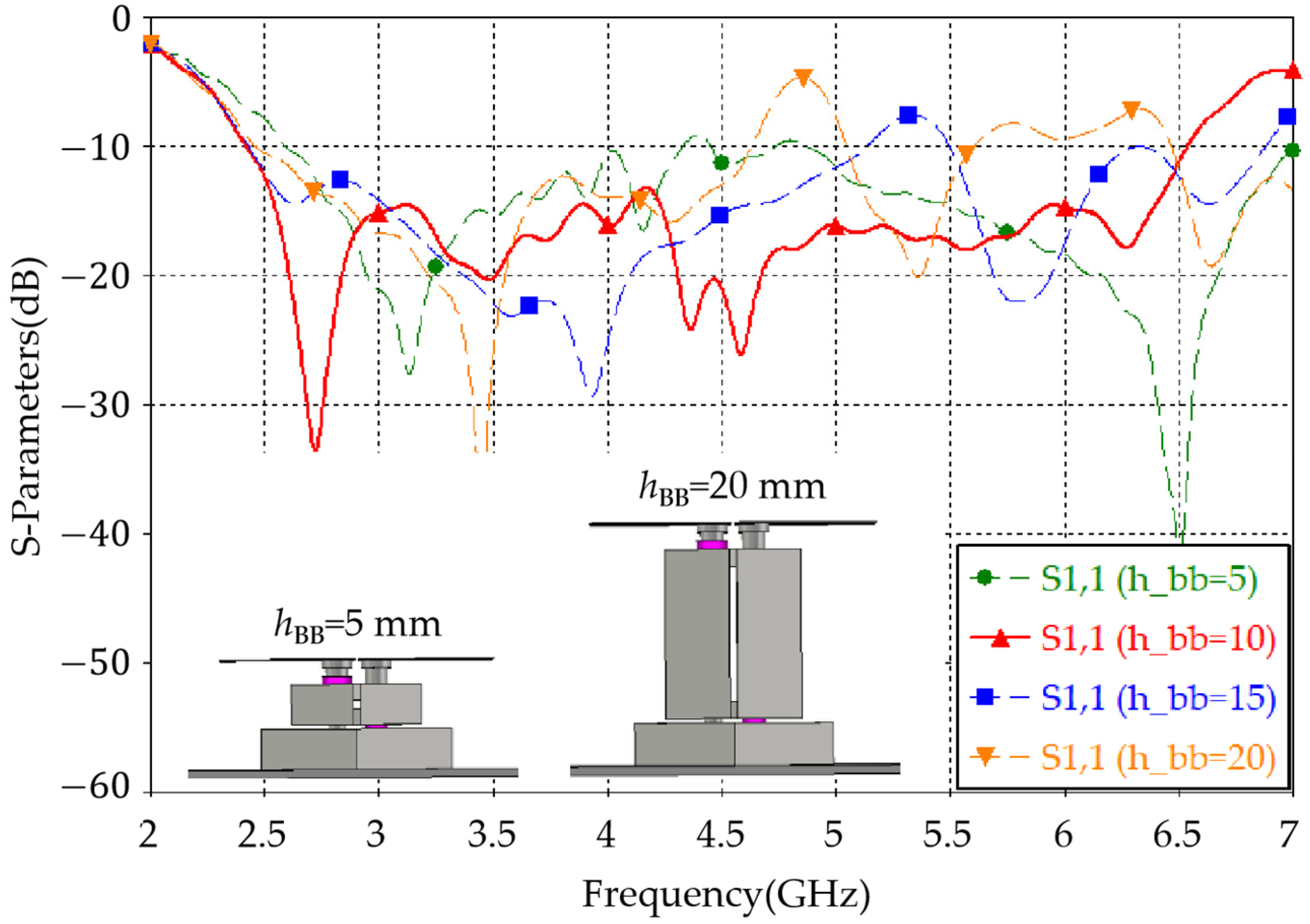


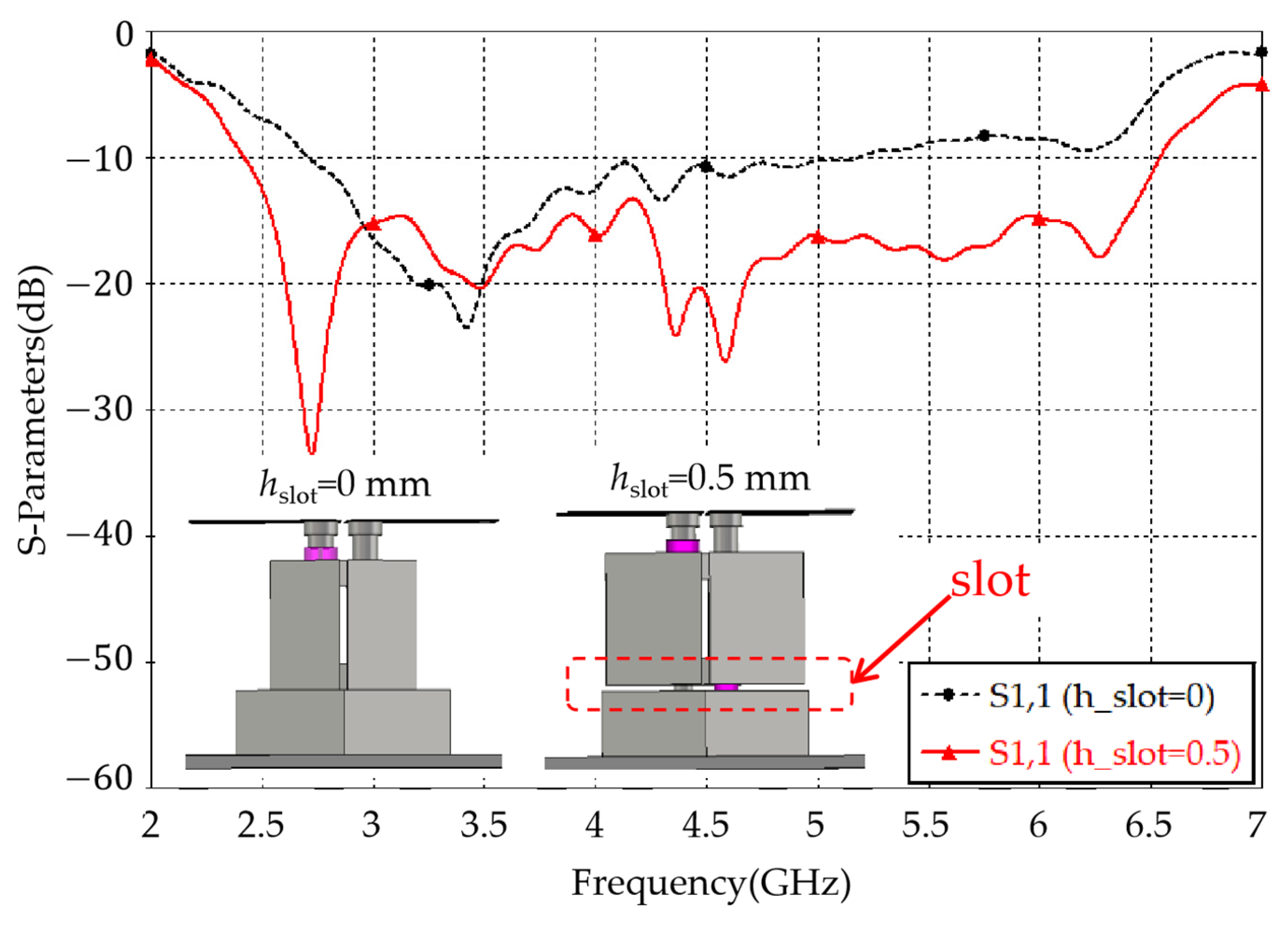








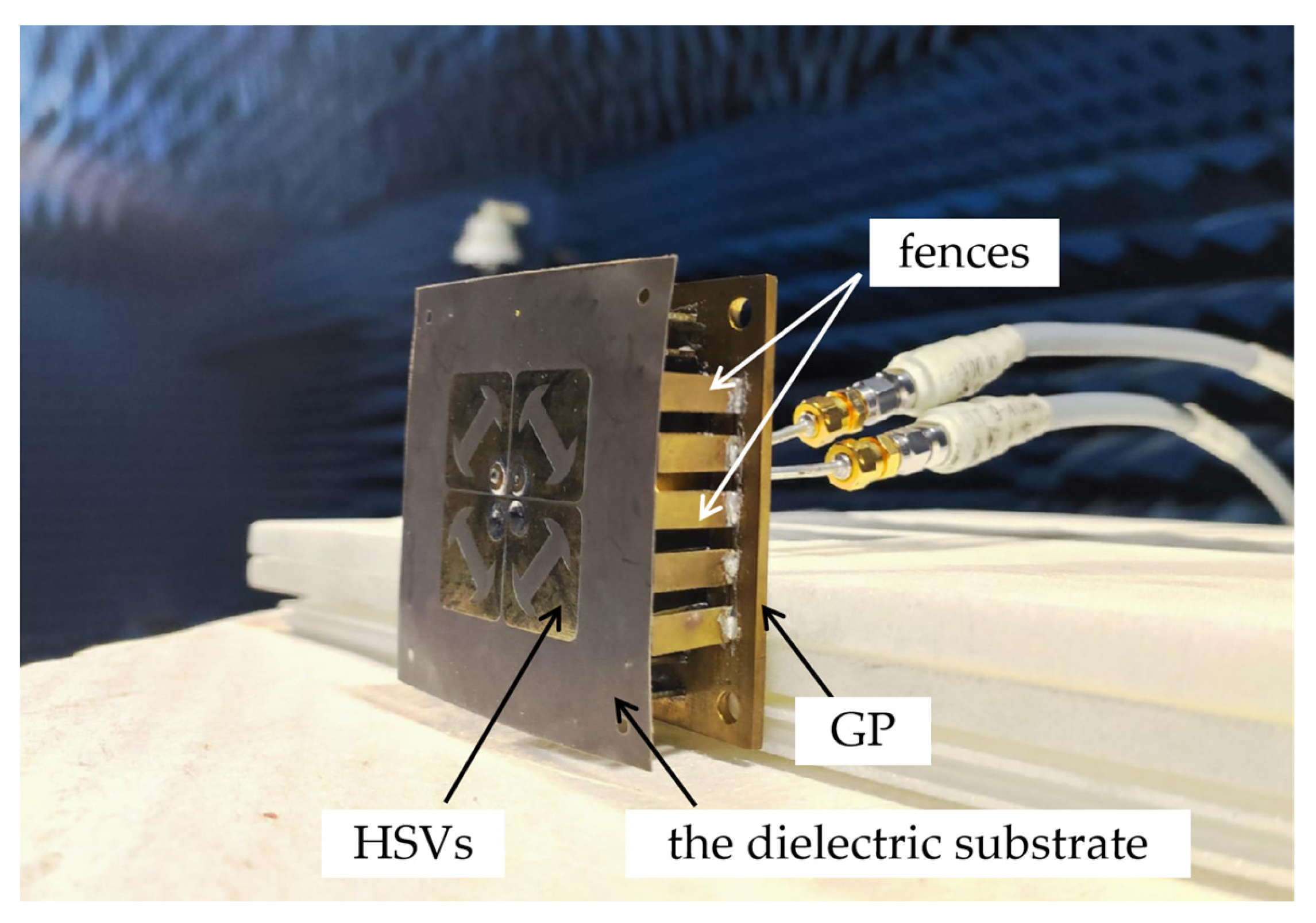
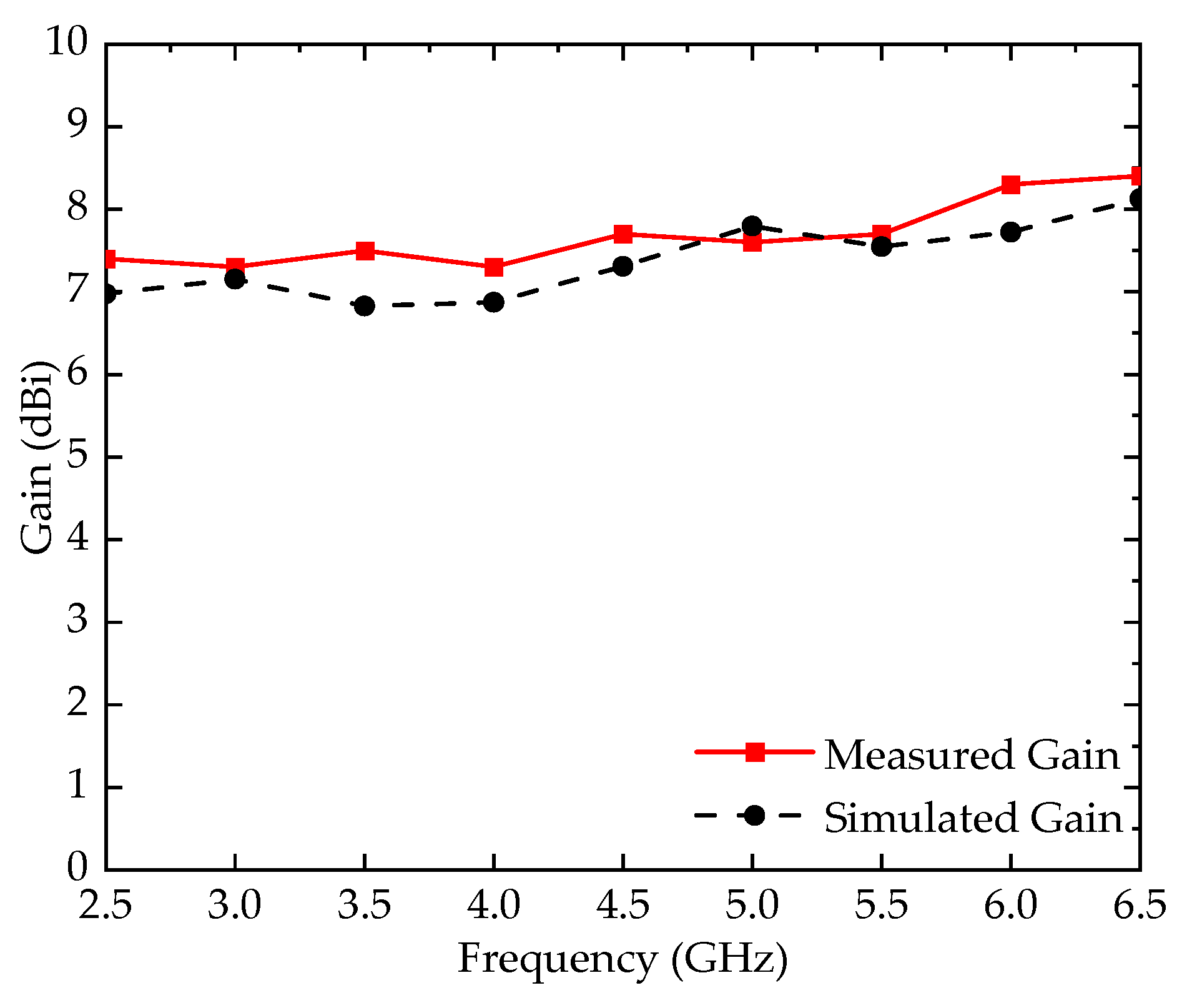
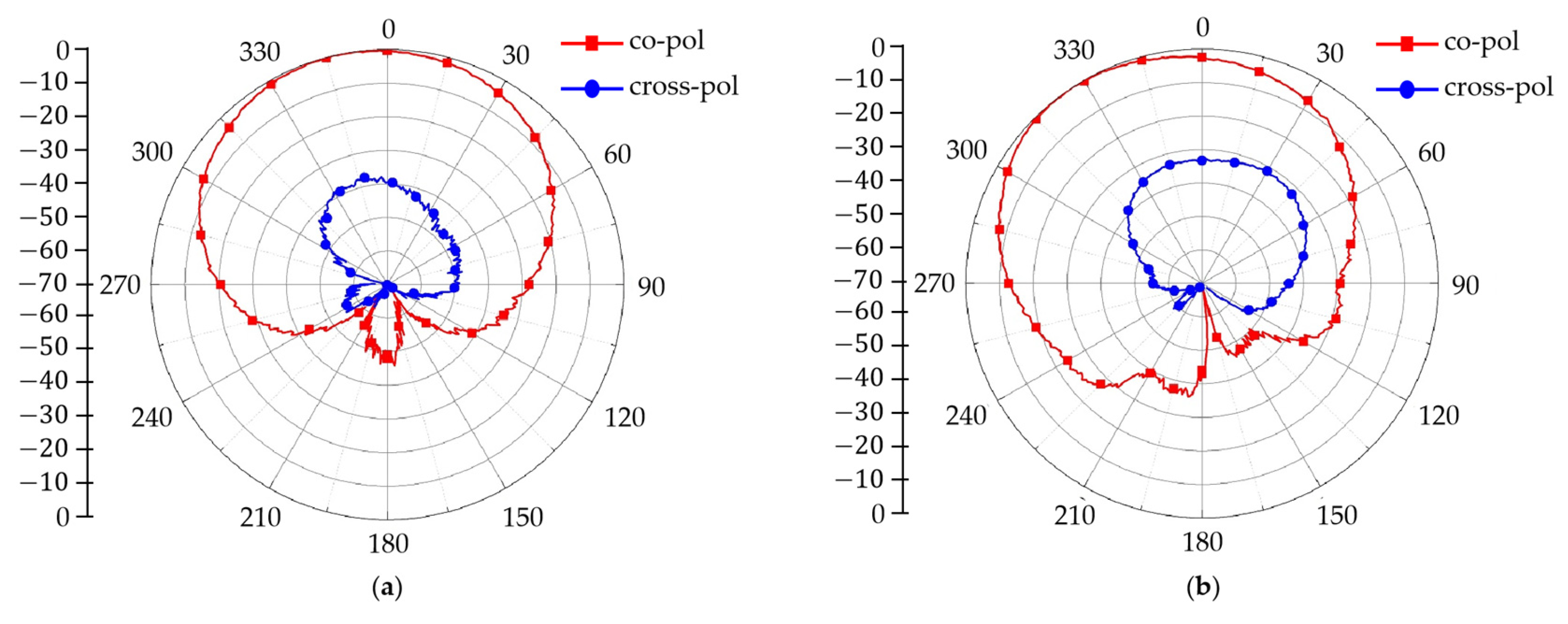
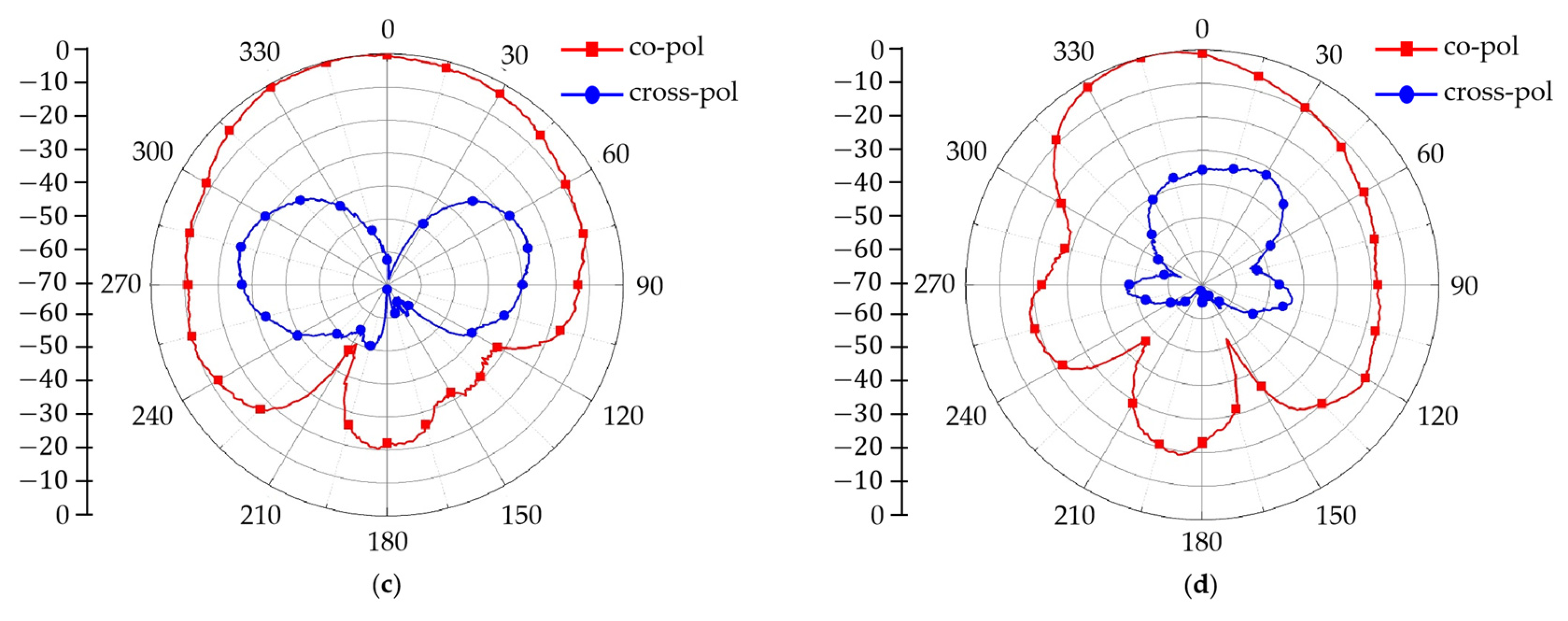
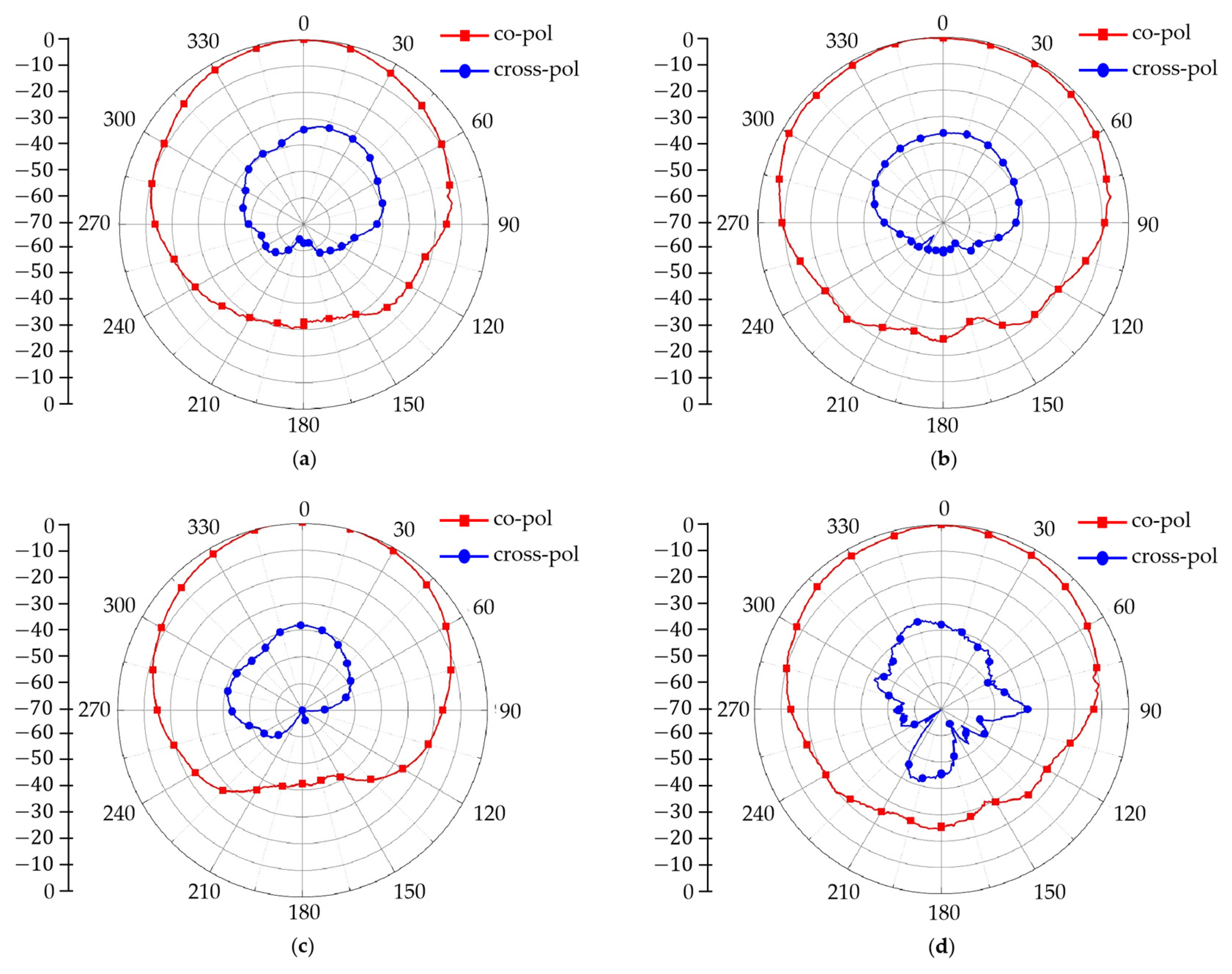
| Dimensions | Value | Dimensions | Value |
|---|---|---|---|
| Dp1 | 4 | Dp2 | 3 |
| hMS1 | 1 | hMS2 | 4.5 |
| hprobe | 3 | hbri | 1 |
| hslot | 1 | hBB | 10 |
| hMP | 5 | hGP | 2 |
| hant | 18.5 | hfence | 15 |
| dMS3 | 3 | lbri2 | 1.5 |
| Dimensions | Value | Dimensions | Value |
|---|---|---|---|
| laslot1 | 10 | laslot2 | 14.8 |
| waslot1 | 3.8 | waslot2 | 3 |
| dprobes | 5.3 | gant | 0.5 |
| lant | 36.5 | lgnd | 65 |
| gBB | 1 | lBB1 | 7 |
| lBB2 | 11.5 | lBB3 | 13 |
| lbri1 | 3 | wbri | 1.5 |
| dxfence | 5 | dyfence | 8 |
| wfence | 5 | tfence | 1 |
| Ref. | Bandwidth | Gain (dBi) | Iso (dB) | XPD (dB) | ||
|---|---|---|---|---|---|---|
| [1] | 51.5% | 4.23 | 0.09 | >28 | >29 | |
| [5] | 91% | 1.79 | 0.13 | >15 | >20 | |
| [9] | 36% | 12.54 | 0.15 | >20 | >16 | |
| [13] | 100% | 3.40 | 0.21 | >20 | >17 | |
| [19] | 32.73% | 0.83 | 0.19 | >20 | >20 | |
| [26] | 53.2% | 4.17 | 0.18 | >22 | >19 | |
| [29] | 133.3% | 3.00 | 0.55 | >18 | >15 | |
| Pro. | 91.2% | 4.45 | 0.15 | >20 | >25 |
Disclaimer/Publisher’s Note: The statements, opinions and data contained in all publications are solely those of the individual author(s) and contributor(s) and not of MDPI and/or the editor(s). MDPI and/or the editor(s) disclaim responsibility for any injury to people or property resulting from any ideas, methods, instructions or products referred to in the content. |
© 2023 by the authors. Licensee MDPI, Basel, Switzerland. This article is an open access article distributed under the terms and conditions of the Creative Commons Attribution (CC BY) license (https://creativecommons.org/licenses/by/4.0/).
Share and Cite
Wu, W.; Yuan, N.; Hu, X.; Xu, Y.; Shi, T. A Novel Bow-Tie Balun-Fed Dual-Polarized Crossed Dipole Antenna. Electronics 2023, 12, 3032. https://doi.org/10.3390/electronics12143032
Wu W, Yuan N, Hu X, Xu Y, Shi T. A Novel Bow-Tie Balun-Fed Dual-Polarized Crossed Dipole Antenna. Electronics. 2023; 12(14):3032. https://doi.org/10.3390/electronics12143032
Chicago/Turabian StyleWu, Weiwei, Naichang Yuan, Xueyi Hu, Yixuan Xu, and Tongtong Shi. 2023. "A Novel Bow-Tie Balun-Fed Dual-Polarized Crossed Dipole Antenna" Electronics 12, no. 14: 3032. https://doi.org/10.3390/electronics12143032
APA StyleWu, W., Yuan, N., Hu, X., Xu, Y., & Shi, T. (2023). A Novel Bow-Tie Balun-Fed Dual-Polarized Crossed Dipole Antenna. Electronics, 12(14), 3032. https://doi.org/10.3390/electronics12143032







